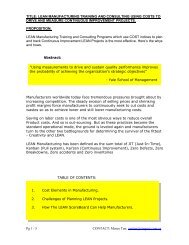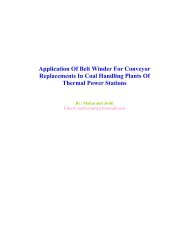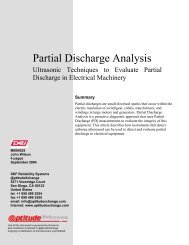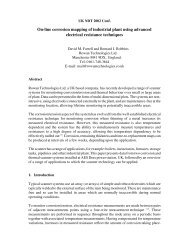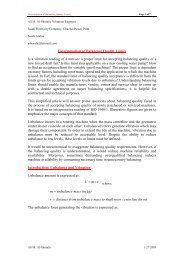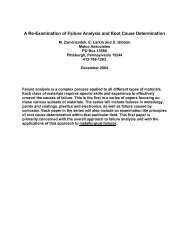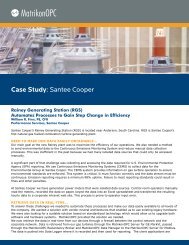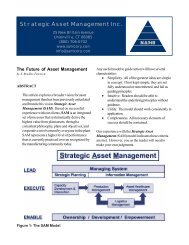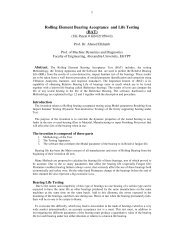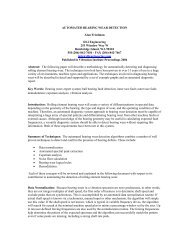Centrifugal Pumps: Basic Concepts of Operation - Plant ...
Centrifugal Pumps: Basic Concepts of Operation - Plant ...
Centrifugal Pumps: Basic Concepts of Operation - Plant ...
Create successful ePaper yourself
Turn your PDF publications into a flip-book with our unique Google optimized e-Paper software.
to the venturi effect is very significant as the velocity at the impeller increases to 15 to 20<br />
ft/s. There is a further drop in pressure due to shock and turbulence as the liquid strikes<br />
and loads the edges <strong>of</strong> impeller vanes. The net effect <strong>of</strong> all the pressure drops is the<br />
creation <strong>of</strong> a very low-pressure area around the impeller eye and at the beginning <strong>of</strong> the<br />
trailing edge <strong>of</strong> the impeller vanes.<br />
The pressure reduction pr<strong>of</strong>ile within the pump is depicted in Figure 9.<br />
Figure 9: Pressure Pr<strong>of</strong>ile in a Pump<br />
As shown in Figure 9, the impeller eye is the point where the static pressure is at a<br />
minimum, p 4. During pump operation, if the local static pressure <strong>of</strong> the liquid at the<br />
lowest pressure becomes equal to or less than the vapor pressure (p v ) <strong>of</strong> the liquid at the<br />
operating temperature, vaporization <strong>of</strong> the liquid (the formation <strong>of</strong> bubbles) begins i.e.<br />
when p 4 ≤ p v.<br />
<strong>Centrifugal</strong> <strong>Pumps</strong>: <strong>Basic</strong>s <strong>Concepts</strong> <strong>of</strong> <strong>Operation</strong>, Maintenance, and Troubleshooting, Part II<br />
By: Mukesh Sahdev, Associate Content Writer<br />
Presented at The Chemical Engineers’ Resource Page, www.cheresources.com
It is at the beginning <strong>of</strong> the trailing edge <strong>of</strong> the vanes near the impeller eye where the<br />
pressure actually falls to below the liquid vapor pressure. The region <strong>of</strong> bubble formation<br />
is shown in Figure 10.<br />
Figure 10: Impeller Cavitation Regions<br />
In summary, vaporization <strong>of</strong> the liquid (bubble formation) occurs due to the<br />
reduction <strong>of</strong> the static pressure to a value below that <strong>of</strong> the liquid vapor pressure. The<br />
reduction <strong>of</strong> static pressure in the external suction system occurs mainly due to friction in<br />
suction piping. The reduction <strong>of</strong> static pressure in the internal suction system occurs<br />
mainly due to the rise in the velocity at the impeller eye.<br />
<strong>Centrifugal</strong> <strong>Pumps</strong>: <strong>Basic</strong>s <strong>Concepts</strong> <strong>of</strong> <strong>Operation</strong>, Maintenance, and Troubleshooting, Part II<br />
By: Mukesh Sahdev, Associate Content Writer<br />
Presented at The Chemical Engineers’ Resource Page, www.cheresources.com
Step Two, Growth <strong>of</strong> bubbles<br />
Unless there is no change in the operating conditions, new bubbles continue to form and<br />
old bubbles grow in size. The bubbles then get carried in the liquid as it flows from the<br />
impeller eye to the impeller exit tip along the vane trailing edge. Due to impeller rotating<br />
action, the bubbles attain very high velocity and eventually reach the regions <strong>of</strong> high<br />
pressure within the impeller where they start collapsing. The life cycle <strong>of</strong> a bubble has<br />
been estimated to be in the order <strong>of</strong> 0.003 seconds.<br />
Step Three, Collapse <strong>of</strong> bubbles<br />
As the vapor bubbles move along the impeller vanes, the pressure around the bubbles<br />
begins to increase until a point is reached where the pressure on the outside <strong>of</strong> the bubble<br />
is greater than the pressure inside the bubble. The bubble collapses. The process is not an<br />
explosion but rather an implosion (inward bursting). Hundreds <strong>of</strong> bubbles collapse at<br />
approximately the same point on each impeller vane. Bubbles collapse nonsymmetrically<br />
such that the surrounding liquid rushes to fill the void forming a liquid<br />
microjet. The micro jet subsequently ruptures the bubble with such force that a<br />
hammering action occurs. Bubble collapse pressures greater than 1 GPa (145x10 6 psi)<br />
have been reported. The highly localized hammering effect can pit the pump impeller.<br />
The pitting effect is illustrated schematically in Figure 11.<br />
Figure 11: Collapse <strong>of</strong> a Vapor Bubble<br />
<strong>Centrifugal</strong> <strong>Pumps</strong>: <strong>Basic</strong>s <strong>Concepts</strong> <strong>of</strong> <strong>Operation</strong>, Maintenance, and Troubleshooting, Part II<br />
By: Mukesh Sahdev, Associate Content Writer<br />
Presented at The Chemical Engineers’ Resource Page, www.cheresources.com
After the bubble collapses, a shock wave emanates outward from the point <strong>of</strong> collapse.<br />
This shock wave is what we actually hear and what we call "cavitation". The implosion<br />
<strong>of</strong> bubbles and emanation <strong>of</strong> shock waves (red color) is shown in a small video clip<br />
available on the website version <strong>of</strong> this article.<br />
In nutshell, the mechanism <strong>of</strong> cavitation is all about formation, growth and collapse <strong>of</strong><br />
bubbles inside the liquid being pumped. But how can the knowledge <strong>of</strong> mechanism <strong>of</strong><br />
cavitation can really help in troubleshooting a cavitation problem. The concept <strong>of</strong><br />
mechanism can help in identifying the type <strong>of</strong> bubbles and the cause <strong>of</strong> their formation<br />
and collapse. The troubleshooting method shall be explored in detail in the next part <strong>of</strong><br />
the article.<br />
Next let us explore the general symptoms <strong>of</strong> cavitation and its affects on pump<br />
performance.<br />
General Symptoms <strong>of</strong> Cavitation and its Affects on Pump Performance<br />
and Pump Parts<br />
Perceptible indications <strong>of</strong> the cavitation during pump operation are more or less loud<br />
noises, vibrations and an unsteadily working pump. Fluctuations in flow and discharge<br />
pressure take place with a sudden and drastic reduction in head rise and pump capacity.<br />
Depending upon the size and quantum <strong>of</strong> the bubbles formed and the severity <strong>of</strong> their<br />
collapse, the pump faces problems ranging from a partial loss in capacity and head to<br />
total failure in pumping along with irreparable damages to the internal parts. It requires a<br />
lot <strong>of</strong> experience and thorough investigation <strong>of</strong> effects <strong>of</strong> cavitation on pump parts to<br />
clearly identify the type and root causes <strong>of</strong> cavitation.<br />
A detailed description <strong>of</strong> the general symptoms is given as under.<br />
• Reduction in capacity <strong>of</strong> the pump:<br />
The formation <strong>of</strong> bubbles causes a volume increase decreasing the space available for the<br />
liquid and thus diminish pumping capacity. For example, when water changes state from<br />
liquid to gas its volume increases by approximately 1,700 times. If the bubbles get big<br />
enough at the eye <strong>of</strong> the impeller, the pump “chokes” i.e. loses all suction resulting in a<br />
total reduction in flow. The unequal and uneven formation and collapse <strong>of</strong> bubbles causes<br />
fluctuations in the flow and the pumping <strong>of</strong> liquid occurs in spurts. This symptom is<br />
common to all types <strong>of</strong> cavitations.<br />
<strong>Centrifugal</strong> <strong>Pumps</strong>: <strong>Basic</strong>s <strong>Concepts</strong> <strong>of</strong> <strong>Operation</strong>, Maintenance, and Troubleshooting, Part II<br />
By: Mukesh Sahdev, Associate Content Writer<br />
Presented at The Chemical Engineers’ Resource Page, www.cheresources.com
• Decrease in the head developed:<br />
Bubbles unlike liquid are compressible. The head developed diminishes drastically<br />
because energy has to be expended to increase the velocity <strong>of</strong> the liquid used to fill up the<br />
cavities, as the bubbles collapse. As mentioned earlier, The Hydraulic Standards Institute<br />
defines cavitation as condition <strong>of</strong> 3 % drop in head developed across the pump. Like<br />
reduction in capacity, this symptom is also common to all types <strong>of</strong> cavitations.<br />
Thus, the hydraulic effect <strong>of</strong> a cavitating pump is that the pump performance drops <strong>of</strong>f <strong>of</strong><br />
its expected performance curve, referred to as break away, producing a lower than<br />
expected head and flow. The Figure 12 depicts the typical performance curves. The solid<br />
line curves represent a condition <strong>of</strong> adequate NPSHa whereas the dotted lines depict the<br />
condition <strong>of</strong> inadequate NPSHa i.e. the condition <strong>of</strong> cavitation.<br />
Figure 12: Pump Performance Curves<br />
<strong>Centrifugal</strong> <strong>Pumps</strong>: <strong>Basic</strong>s <strong>Concepts</strong> <strong>of</strong> <strong>Operation</strong>, Maintenance, and Troubleshooting, Part II<br />
By: Mukesh Sahdev, Associate Content Writer<br />
Presented at The Chemical Engineers’ Resource Page, www.cheresources.com
• Abnormal sound and vibrations:<br />
It is movement <strong>of</strong> bubbles with very high velocities from low-pressure area to a highpressure<br />
area and subsequent collapse that creates shockwaves producing abnormal sounds<br />
and vibrations. It has been estimated that during collapse <strong>of</strong> bubbles the pressures <strong>of</strong> the<br />
order <strong>of</strong> 10 4 atm develops.<br />
The sound <strong>of</strong> cavitation can be described as similar to small hard particles or<br />
gravel rapidly striking or bouncing <strong>of</strong>f the interior parts <strong>of</strong> a pump or valve. Various terms<br />
like rattling, knocking, crackling are used to describe the abnormal sounds. The sound <strong>of</strong><br />
pumps operating while cavitating can range from a low-pitched steady knocking sound<br />
(like on a door) to a high-pitched and random crackling (similar to a metallic impact).<br />
People can easily mistake cavitation for a bad bearing in a pump motor. To distinguish<br />
between the noise due to a bad bearing or cavitation, operate the pump with no flow. The<br />
disappearance <strong>of</strong> noise will be an indication <strong>of</strong> cavitation.<br />
Similarly, vibration is due to the uneven loading <strong>of</strong> the impeller as the mixture <strong>of</strong> vapor<br />
and liquid passes through it, and to the local shock wave that occurs as each bubble<br />
collapses. Very few vibration reference manuals agree on the primary vibration<br />
characteristic associated with pump cavitation. Formation and collapsing <strong>of</strong> bubbles will<br />
alternate periodically with the frequency resulting out <strong>of</strong> the product <strong>of</strong> speed and number<br />
<strong>of</strong> blades. Some suggest that the vibrations associated with cavitation produce a<br />
broadband peak at high frequencies above 2,000 Hertz. Some suggest that cavitation<br />
follows the vane pass frequency (number <strong>of</strong> vanes times the running speed frequency)<br />
and yet another indicate that it affects peak vibration amplitude at one times running<br />
speed. All <strong>of</strong> these indications are correct in that pump cavitation can produce various<br />
vibration frequencies depending on the cavitation type, pump design, installation and use.<br />
The excessive vibration caused by cavitation <strong>of</strong>ten subsequently causes a failure <strong>of</strong> the<br />
pump’s seal and/or bearings. This is the most likely failure mode <strong>of</strong> a cavitating pump,<br />
• Damage to pump parts:<br />
o Cavitation erosion or pitting<br />
During cavitation, the collapse <strong>of</strong> the bubbles occurs at sonic speed ejecting<br />
destructive micro jets <strong>of</strong> extremely high velocity (up to 1000 m/s) liquid strong<br />
enough to cause extreme erosion <strong>of</strong> the pump parts, particularly impellers. The<br />
bubble is trying to collapse from all sides, but if the bubble is lying against a piece<br />
<strong>of</strong> metal such as the impeller or volute it cannot collapse from that side. So the<br />
fluid comes in from the opposite side at this high velocity and bangs against the<br />
metal creating the impression that the metal was hit with a "ball pin hammer".<br />
The resulting long-term material damage begins to become visible by so called<br />
<strong>Centrifugal</strong> <strong>Pumps</strong>: <strong>Basic</strong>s <strong>Concepts</strong> <strong>of</strong> <strong>Operation</strong>, Maintenance, and Troubleshooting, Part II<br />
By: Mukesh Sahdev, Associate Content Writer<br />
Presented at The Chemical Engineers’ Resource Page, www.cheresources.com
Pits (see Figure 11), which are plastic deformations <strong>of</strong> very small dimensions<br />
(order <strong>of</strong> magnitude <strong>of</strong> micrometers). The damage caused due to action <strong>of</strong> bubble<br />
collapse is commonly referred as Cavitation erosion or pitting. The Figure 13<br />
depicts the cavitation pitting effect on impeller and diffuser surface.<br />
Figure 13: Photographic Evidence <strong>of</strong> Cavitation<br />
Cavitation erosion from bubble collapse occurs primarily by fatigue fracture due<br />
to repeated bubble implosions on the cavitating surface, if the implosions have<br />
sufficient impact force. The erosion or pitting effect is quite similar to sand<br />
blasting. High head pumps are more likely to suffer from cavitation erosion,<br />
making cavitation a “high-energy” pump phenomenon.<br />
The most sensitive areas where cavitation erosion has been observed are the<br />
low-pressure sides <strong>of</strong> the impeller vanes near the inlet edge. The cavitation<br />
erosion damages at the impeller are more or less spread out. The pitting has also<br />
been observed on impeller vanes, diffuser vanes, and impeller tips etc. In some<br />
instances, cavitation has been severe enough to wear holes in the impeller and<br />
damage the vanes to such a degree that the impeller becomes completely<br />
ineffective. A damaged impeller is shown in Figure 14.<br />
<strong>Centrifugal</strong> <strong>Pumps</strong>: <strong>Basic</strong>s <strong>Concepts</strong> <strong>of</strong> <strong>Operation</strong>, Maintenance, and Troubleshooting, Part II<br />
By: Mukesh Sahdev, Associate Content Writer<br />
Presented at The Chemical Engineers’ Resource Page, www.cheresources.com
Figure 14: Cavitation Damage on Impellers<br />
The damaged impeller shows that the shock waves occurred near the outside edge<br />
<strong>of</strong> the impeller, where damage is evident. This part <strong>of</strong> the impeller is where the<br />
pressure builds to its highest point. This pressure implodes the gas bubbles,<br />
changing the water’s state from gas into liquid. When cavitation is less severe,<br />
the damage can occur further down towards the eye <strong>of</strong> the impeller. A careful<br />
investigation and diagnosis <strong>of</strong> point <strong>of</strong> the impeller erosion on impeller, volute,<br />
diffuser etc. can help predict the type and cause <strong>of</strong> cavitation.<br />
The extent <strong>of</strong> cavitation erosion or pitting depends on a number <strong>of</strong> factors like<br />
presence <strong>of</strong> foreign materials in the liquid, liquid temperature, age <strong>of</strong> equipment<br />
and velocity <strong>of</strong> the collapsing bubble.<br />
<strong>Centrifugal</strong> <strong>Pumps</strong>: <strong>Basic</strong>s <strong>Concepts</strong> <strong>of</strong> <strong>Operation</strong>, Maintenance, and Troubleshooting, Part II<br />
By: Mukesh Sahdev, Associate Content Writer<br />
Presented at The Chemical Engineers’ Resource Page, www.cheresources.com
o Mechanical deformations<br />
Apart from erosion <strong>of</strong> pump parts, in bigger pumps, longer duration <strong>of</strong> cavitation<br />
condition can result in unbalancing (due to un-equal distribution in bubble<br />
formation and collapse) <strong>of</strong> radial and axial thrusts on the impeller. This<br />
unbalancing <strong>of</strong>ten leads to following mechanical problems:<br />
• bending and deflection <strong>of</strong> shafts,<br />
• bearing damage and rubs from radial vibration,<br />
• thrust bearing damage from axial movement,<br />
• breaking <strong>of</strong> impeller check-nuts,<br />
• seal faces damage etc.<br />
These mechanical deformations can completely wreck the pump and require<br />
replacement <strong>of</strong> parts. The cost <strong>of</strong> such replacements can be huge.<br />
o Cavitation corrosion<br />
Frequently cavitation is combined with corrosion. The implosion <strong>of</strong> bubbles<br />
destroys existing protective layers making the metal surface permanently<br />
activated for the chemical attack. Thus, in this way even in case <strong>of</strong> slight<br />
cavitation it may lead to considerable damage to the materials. The rate <strong>of</strong> erosion<br />
may be accentuated if the liquid itself has corrosive tendencies such as water with<br />
large amounts <strong>of</strong> dissolved oxygen to acids.<br />
Cavitation – heart attack <strong>of</strong> the pump<br />
Thus fundamentally, cavitation refers to an abnormal condition inside the pump<br />
that arises during pump operation due to formation and subsequent collapse <strong>of</strong> vapor<br />
filled cavities or bubbles inside the liquid being pumped. The condition <strong>of</strong> cavitation can<br />
obstruct the pump, impair performance and flow capacity, and damage the impeller and<br />
other sensitive components. In short, Cavitation can be termed as “the heart attack <strong>of</strong><br />
the pump”.<br />
<strong>Centrifugal</strong> <strong>Pumps</strong>: <strong>Basic</strong>s <strong>Concepts</strong> <strong>of</strong> <strong>Operation</strong>, Maintenance, and Troubleshooting, Part II<br />
By: Mukesh Sahdev, Associate Content Writer<br />
Presented at The Chemical Engineers’ Resource Page, www.cheresources.com
References<br />
1. “ New Monitoring Systems Warns <strong>of</strong> Cavitation and Low Flow Instabilities”, <strong>Pumps</strong> and<br />
Systems Magazine, April 1996, Robert A. Atkins, Chung E.Lee, Henry F.Taylor<br />
2. “Understanding Pump Cavitation”, Chemical Processing, Feb 1997, W.E. Nelson<br />
3. “<strong>Centrifugal</strong> pumps operation at <strong>of</strong>f-design conditions”, Chemical Processing April, May,<br />
June 1987, Igor J. Karassik<br />
4. “Understanding NPSH for <strong>Pumps</strong>”, Technical Publishing Co. 1975, Travis F. Glover<br />
5. “<strong>Centrifugal</strong> <strong>Pumps</strong> for General Refinery Services”, Refining Department, API Standard<br />
610, 6th Edition, January 1981<br />
6. “Controlling <strong>Centrifugal</strong> <strong>Pumps</strong>”, Hydrocarbon Processing, July 1995, Walter Driedger<br />
7. “Don’t Run <strong>Centrifugal</strong> <strong>Pumps</strong> Off The Right Side <strong>of</strong> the Curve”, Mike Sondalini<br />
8. “Pump Handbook”, Third Edition, Igor j. Karassik, Joseph P.Messina, Paul cooper<br />
Charles C.Heald<br />
9. "<strong>Centrifugal</strong> <strong>Pumps</strong> and System Hydraulics", Chemical Engineering, October 4, 1982,<br />
pp. 84-106. , Karassik, I.J.,<br />
10. Unit <strong>Operation</strong>s <strong>of</strong> Chemical Engineering (5th Edition), McGraw-Hill, 1993, pp. 188-<br />
204. , McCabe, W.L., J.C. Smith, and P. Harriott,<br />
11. “CAVISMONITOR: Cavitation Monitoring In Hydraulic Machines With Aid Of A<br />
Computer Aided Visualization Method”, Bernd Bachert, Henrik Lohrberg, Bernd St<strong>of</strong>fel<br />
Laboratory for Turbomachinery and Fluid Power Darmstadt University <strong>of</strong> Technology<br />
Magdalenenstrasse 4, 64289 Darmstadt, Germany<br />
12. “The Hydraulic Pump Inlet Condition: Impact on Hydraulic Pump Cavitation Potential”,<br />
G.E. Totten and R.J. Bishop, Jr.Union Carbide Corporation Tarrytown, NY<br />
13. "Study <strong>of</strong> Cavitation Collapse Pressure and Erosion, Part I: A Method for Measurement<br />
<strong>of</strong> Collapse Pressure", Wear, 1989, Vol. 133, p.219-232, T. Okada, Y. Iwai and K.<br />
Awazu,<br />
14. “Key <strong>Centrifugal</strong> Pump Parameters and How They Impact Your Applications” Part 1<br />
<strong>Pumps</strong> and Systems: They Go Together, Doug Kriebel, PE, Kriebel Engineered<br />
Equipment<br />
15. “How to compute Net Positive Suction Head for centrifugal pumps”. J. J. Paugh,<br />
P.E.Vice President, Engineering, Warren <strong>Pumps</strong> Inc.<br />
16. “New Monitoring System Warns <strong>of</strong> Cavitation and Low-Flow Instabilities”, APRIL 1996<br />
PUMPS AND SYSTEMS MAGAZINE, Robert A. Atkins, Chung E. lee and Henry F.<br />
Taylor<br />
17. “Detecting Cavitation in <strong>Centrifugal</strong> <strong>Pumps</strong>”, Experimental Results <strong>of</strong> the Pump<br />
Laboratory, Jeremy Jensen Project Engineer, Bentley Rotor Dynamics Research<br />
Corporation<br />
<strong>Centrifugal</strong> <strong>Pumps</strong>: <strong>Basic</strong>s <strong>Concepts</strong> <strong>of</strong> <strong>Operation</strong>, Maintenance, and Troubleshooting, Part II<br />
By: Mukesh Sahdev, Associate Content Writer<br />
Presented at The Chemical Engineers’ Resource Page, www.cheresources.com



